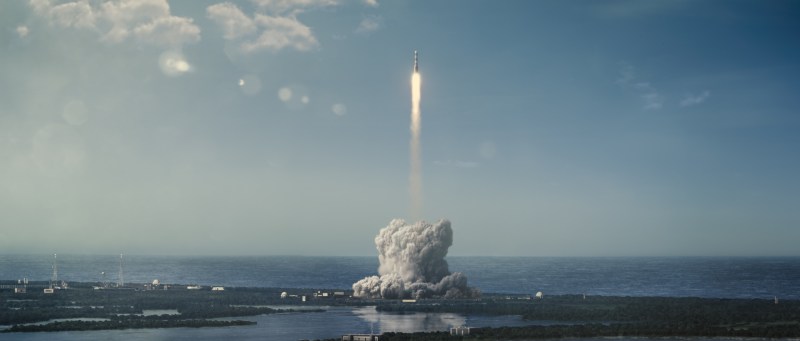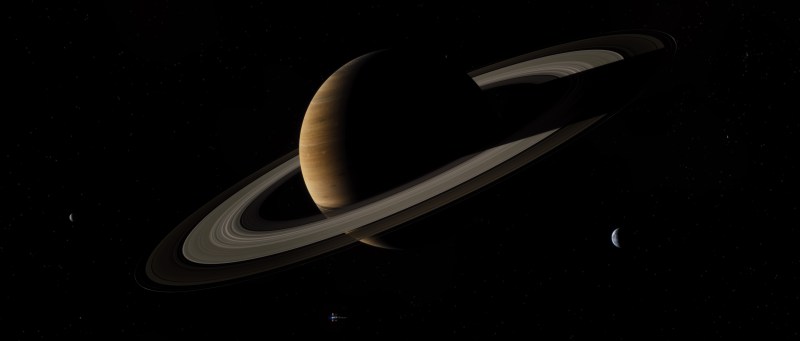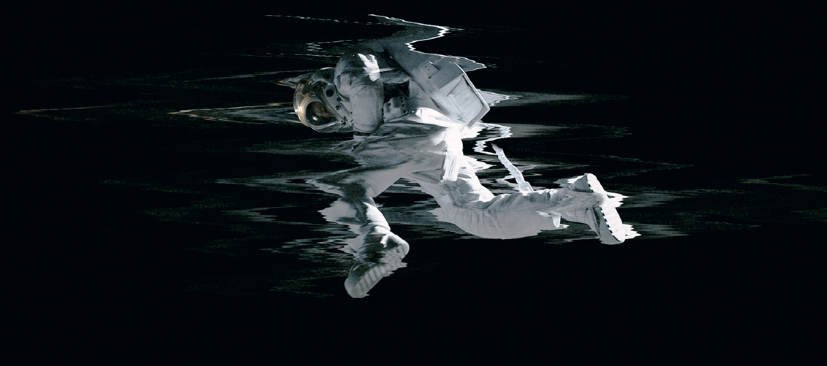A full global quiver of studios worked tirelessly to help create scenes of immense reality on Ad Astra, this ‘Brad-Pitt-in-space’ paranoid thriller. The VFX crews created vistas of Earth from high altitude, rocket launches from Earth, the Moon, then Mars and scenes from the orbit of Neptune.
Many studios were allocated sequences of effects. MPC, Method Studios, Mr. X, Weta Digital, Capital T., Halon Entertainment, ILM, Shade VFX, and many others collaborated on this massive undertaking.

The story of Ad Astra follows Roy McBride (Brad Pitt) on a mission across the solar system to find his missing father and his doomed expedition that now threatens the stability of the solar system. VFX Supervisors from these studios worked to visualise a real journey, creating with a visual style leaning towards realism over fantasy, overseen by Allen Maris.
Buoyed by the work of cinematographer Hoyte Van Hoytema, this immense Plan B Entertainment production is visually stunning and in particular, MPC created almost 200 shots for the movie. Adding them up, MPC created the sequence involving the launch from Earth, landing at the lunar base, the design of the base, and the launch from the lunar base, among other sequences.

Actual North Pole bases were used as a reference for the creation of the Moonbase. By gathering all of the height field data available and rebuilding the environment from there, the real-world light direction was also studied. The development of the Moonbase was particularly complex. Several concept designs were attempted before finding Director James Gray’s vision of having a clean and streamlined base, but large and grand in nature.

“We had a lot of back and forth to get the initial buy off on the underlying geometry,” says Oliver Winwood, CG Supervisor at MPC London for Ad Astra. “Following on, a lot of paintwork was done to add in the details required to represent the sheer scale of the bases.” The lighting in this production was brilliant. There are stark references in lighting of some of the sequences on Mars that nod wildly at Blade Runner 2049, especially on Mars.
A gripping rover chase across the barren grey lunar landscape was awarded to Method Studios. The ‘space-pirates’ chase was filmed out in the Dumont Dunes of Death Valley in southern California, halfway between Los Angeles and Las Vegas. This was shot in Infra-red, using Arri Alexa XT digital cameras. The rest of the production was filmed on 35mm with prime lenses. Feel free to play the video from WIRED; below.
While working on Ad Astra, James Gray would often reflect on 2001: A Space Odyssey, which he called the genre’s greatest accomplishment, in part because of the way director Stanley Kubrick used the isolation of space to tell a very different story.
At times when Brad Pitt was seen hanging in the void between spacecraft, out in the entirely CG space of Neptune’s orbit, Gray said he struggled with where to put the camera. For the director, the first duty each day is to work on the staging of shots with his actors. But he couldn’t interact with a real location or set because at that stage, there wasn’t one.
PLANETS
MPC worked with studio Mr X to tackle the scale and to define the iconic view of Neptune and its rings. They used Terragen software and then broke down these shots for greater control of the details and angles required. The team also built a realistic starfield using data from NASA with world accurate star brightness values rendered out as an HDRI for intricately correct projection.

“The appearance of the rings of Neptune were particularly important in helping the audience understand the journey through the sequence,” Winwood continues. “These also provided a unique colour palette, emphasising the cold of deep space with its blue cool hues.” The rings were used to establish the relationship between the two spacecraft, Cepheus and Lima Station, as well as the travel away from the Lima and Neptune when Clifford and Roy spin out of control into the darkness of space. In one sequence, Roy uses the rings to re-orient himself and make his journey back to the Cepheus.
“The rings of Neptune themselves were made up from layers of volume, particles and instanced rock debris and were created by the MPC team in Vancouver, led by CG Supervisor Terry Thompson,” explains Winwood. “This gave us a lot of flexibility to reorient and frame the rings as shots required.”
There were a lot of shots depicting zero gravity. The technique was to film actors from below, hanging from guidelines. This instantly took me back to my favourite 60s SciFi classic, 2001: A Space Odyssey.
The Roy character (Brad Pitt) was filmed on black with a strong key light to replicate a single strong directional light in space. “A combination of wirework and motion-controlled rigs were used to move the actors around,” says Winwood, “meaning a lot of our work involved taking plates of the actors and then adding in the environment around them.”

These scenes were also shot in slight slow-motion to help give an impression of weightlessness to the actor’s motion. CG doubles were used where necessary to replace visors as well as to aid in the removal of the motion-controlled rig when it was too complicated to prep out.
“We had a number of full CG shots as well, these were interesting when directing the animation and working out which parts of the body should move, for example, when pulling yourself along a tether in zero gravity. For these shots we referenced footage of astronauts on spacewalks, as well as looking at the surrounding plate shots, to find a good balance between what was shot and our reference, to ensure the full CG shots blended seamlessly into the sequence.”

SHIPBUILDING
One of the biggest assets MPC created was Cepheus, the main ship Roy uses to travel across the solar system. Similar to the moon base, the concept art for Cepheus was highly developed, down to its ISS style sections and smaller outer detail. Particular care and attention were put towards creating realistic smoke plumes for take-off.

“The ships for the voyage between Earth to Moon, on to Mars and along with Lima Station, used to travel across to Neptune were built by our Asset team at MPC Bangalore,” says Winwood. “We had good concept design from the client on which we based our builds. The designs are very practical and aren’t glamourised, meaning we could leverage a lot of footage of real-world ships and space stations for the materials.
The concept from the client for the Cepheus was highly developed, and Winwood says the resulting asset MPC built had a little-to-no deviation from its initial look throughout the creation process. “With its ISS style sections and smaller outer details for functionality,” he describes, “the asset was the same across the entire trip, with additional escape pods on the exterior for additional story points.”
For Eric Andrusyszyn, as Compositing Supervisor at MPC London, there was an immense creative kick from assembling final image scenes, giving it that final look. “There’s certainly a thrill to creating something visual out of nothing, and compositing is a huge part of that,” says Andrusyszyn. “There’s an artistic liberation in the sense of creating something new that people are going to enjoy watching, and I was pleased with the audience reactions when I saw it again after the crew screening.”

EARTH LAUNCH
The construction of the shot of the rocket launch from Earth began with the DMP (Digital Matte Painting) department. “It is clearly a large job compositing, creating the visual representation, building all the layers of the atmosphere as the launch vehicle makes its way up into space,” explains Andrusyszyn. “There were all kinds of studies we looked into about how light would bounce off water and the earth surface, and how cloud layers would interact with that view. All to strengthen that sense of depth and size, and to lend that sense of presence.”
When a shot comes through from the lighting department, each individual light used to create the image at their end, is broken out. While it varies from company to company, the compositing crew at MPC are given the freedom to push things around a fair bit, and of course, this depends on time as well.

Andrusyszyn also mentions the meticulous attention given in compositing, to specular highlights, especially on the shuttles and other craft surfaces. “We took a long time making sure we understood how a craft was lit, and how the surface reacted to light. We spent a long time looking at NASA footage, examining how specular highlights react to lighting on the moon, close-ups of moon rocks, even to the extent of recolouring of the rocks at different angles, and lens flare. While there are so many references to go through, we’re making sure we’re getting all the small details of how the light and surfaces dance together.”
In one sequence later on in the movie, where Roy and his father meet in Neptune orbit, they leave the Lima Station and float freely. Director James Gray had a very strong vision where he wanted something very tangible. He wanted the surroundings to be instantly recognisable as something that would work, something that had a link to reality.
SPACE FLOAT
They shot reference to the Neptune sequence as Brad Pitt floats on wires. “The weightlessness was simulated that way,” explains Andrusyszyn, “but instead of shooting against a normal blue or green screen, which would involve us creating a key to take him off the plate and put him somewhere else, they pretty much simulated a real-world space, with one light from the sun. They shot him against a very dark background, and relied on rotoscoping to pull him off the plate.”

The Neptune sequence was definitely the hardest to develop. Multiple cloud layers, strings of debris within the rings, these elements make up a major part of the action later in the plot. MPC has worked on many movies with the theme of voyages in outer space of course, like Prometheus and Alien: Covenant. I feel the industry has ratcheted up a few notches, and with Ad Astra, the level of VFX output has matured from these studios involved.
Related links:
